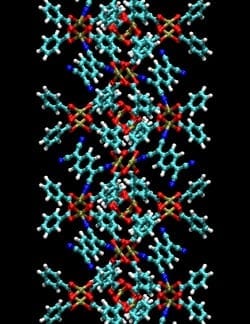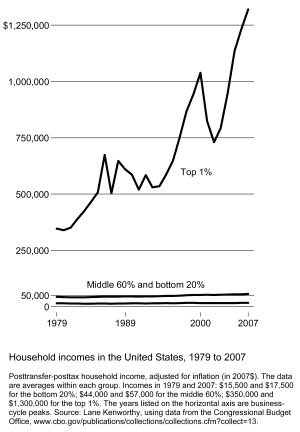
The conductivity in the material, he says, is now a million times higher than that of the starting material, and a thousand times higher than anything previously reported using a metal-organic framework.
Sandia National Laboratories researchers have devised a novel way to realize electrical conductivity in metal-organic framework (MOF) materials, a development that could have profound implications for the future of electronics, sensors, energy conversion and energy storage.
A paper to appear in Science magazine, “Tunable Electrical Conductivity in Metal-Organic Framework Thin-Film Devices,” debuted in the Dec. 5 edition of Science Express. The paper — co-authored by a group of Sandia researchers and collaborators at the National Institute of Standards and Technology(NIST) — describes a technique that experiments show successfully increases the electrical conductivity of one MOF by over six orders of magnitude.
“Fundamentally, this sheds enormous light on the conduction process in these materials,” said Alec Talin, a material scientist at Sandia and the paper’s lead author.
Applications for electrically conducting MOFs, said Sandia senior scientist Mark Allendorf, include chemical sensing, medical diagnostics, energy harvesting and storage and microelectronics.
MOFs: “Tinkertoys” for chemists
Materials researchers have considered MOF materials primarily for use in gas storage, drug delivery and other conventional applications for porous materials. Their crystalline structure, which resembles molecular scaffolding, consists of rigid organic molecules linked together by metal ions. This hybrid of inorganic and organic components produces an unusual combination of properties: nanoporosity, ultrahigh surface areas and remarkable thermal stability, which are attractive to chemists seeking novel materials that combine the superior performance of traditional inorganic semiconductors with the low cost and ease of fabrication typical of conducting organic polymers.
Allendorf, a chemist and MOF expert who called the research findings the most exciting development in his 28-year Sandia career, likens them to “tinker toys” for chemists.
“When you imagine the ‘Tinkertoys’ we played with as children, you recall they are essentially wooden balls with holes that you can link together with sticks,” Allendorf explained. “MOFs work the same way, only you substitute metal ions for the balls and organic molecules for the sticks.”
The resulting open space within the scaffolding can be filled with guest molecules, which gave Sandia’s Talin the idea to use the pore to make the MOFs electrically conducting.
“Importantly, MOFs possess a characteristic of molecules that allows us to adapt their properties to a specific application: we can perform chemistry on them, unlike traditional inorganic electronic materials, such as silicon and copper,” said Talin. Molecules, he said, represent the “ultimate, small-scale unit” at which electronic devices can be made. They are so difficult to manipulate and organize, however, that practical “molecular electronics” have not been realized. “How you connect to molecules, where you place them — those issues have consistently perplexed materials scientists,” said Talin.
The Latest on: Electrically conducting MOFs
- When does a conductor not conduct? Switching a 2D metal-organic framework from an insulator to a metalon April 29, 2024 at 7:40 am
An Australian-led study has found unusual insulating behavior in a new atomically-thin material—and the ability to switch it on and off.
- Switching a 2D metal-organic framework from an insulator to a metalon April 28, 2024 at 5:00 pm
Materials that feature strong interactions between electrons can display unusual properties such as the ability to act as insulators even when they are expected to conduct electricity ... we can tune ...
- Here Are the 11 Cheapest Electric Vehicles You Can Buyon April 25, 2024 at 5:00 pm
So you’ve decided to take a gamble on an electric vehicle, but you’d like to keep the ante down for getting into the game. There are lots of good reasons not to spend the kids’ college fund ...
- Electric Motorcycleson April 24, 2024 at 5:00 pm
Harley-Davidson’s LiveWire company unveiled its third electric motorcycle in March: the S2 Mulholland. At first glance, the electric cruiser closely resembles the existing LiveWire S2 Del Mar ...
- The Best Electric Kettles of 2024on April 23, 2024 at 12:59 pm
David lives in Brooklyn where he's spent more than a decade covering all things edible, including meal kit services, food subscriptions, kitchen tools and cooking tips. He earned a BA in English ...
- The 5 best electric scrubbers for spring cleaning in 2024on April 17, 2024 at 9:46 am
There are so many electric scrubbers on the market, especially on Amazon, that first-time shoppers may be overwhelmed. That's why we did the work for you and came up with the best electric ...
- Best Electric Carson February 20, 2024 at 2:33 am
The Ioniq 6 creates a strong first impression with its unusual, aerodynamically efficient design. As an EV, it gets pretty much everything right: fast recharging, a great one-pedal drive mode, and ...
- Electric carson January 6, 2024 at 1:42 am
EV shoppers have concerns about electric car batteries, but those concerns likely are focused on the wrong thing. We’ll explain how to best preserve your EV’s battery capacity and range.
- Best Electric Carson January 3, 2024 at 12:08 am
Can you charge an electric car at home? Home charging is generally the most cost-effective way to charge an electric car. With the right at-home charging equipment, many electric cars can achieve ...
via Bing News
The Latest on: Metal-organic framework
- When does a conductor not conduct? Switching a 2D metal-organic framework from an insulator to a metalon April 29, 2024 at 7:40 am
An Australian-led study has found unusual insulating behavior in a new atomically-thin material—and the ability to switch it on and off.
- Switching a 2D metal-organic framework from an insulator to a metalon April 28, 2024 at 5:00 pm
The atomically thin (or ‘2D’) material at the heart of the study is a type of MOF, a class of materials composed from organic molecules and metal atoms. “Thanks to the versatility of supramolecular ...
- Why Mike Cannon-Brookes invested in this mushroomon April 28, 2024 at 12:01 pm
A tree-planting boom is required to get the world to net-zero, and the billionaire is betting mushrooms and fungi will be a crucial enabler ...
- Scientists Develop Battery Capable of Rapid Charging in Just a Few Secondson April 26, 2024 at 2:35 pm
Sodium (Na), being more than 500 times as abundant as lithium (Li), has recently attracted considerable interest for its potential use in sodium-ion battery technologies. However, existing sodium-ion ...
- Team develops new testing system for carbon capture in fight against global warmingon April 25, 2024 at 11:32 pm
More than 100 facilities designed to remove carbon dioxide (CO2) from the atmosphere are in various stages of development around the world. In the United States, the first direct air capture (DAC) ...
- IDTechEx Forecasts Metal-Organic Frameworks Market to Grow to US$685 Million by 2034on April 25, 2024 at 3:17 am
Metal-organic frameworks (MOFs) are a class of materials with exceptionally high porosity and surface area (up to 7000m2/g). The design flexibility and structural versatility afforded by MOFs have ...
- When nano- meets climate technologyon April 22, 2024 at 4:59 pm
MOFs, with their lattice framework made of metal ions, or clusters coordinated with organic ligands, contain microscopic unfilled areas within their structure. These “voids” or “pores” enable hydrogen ...
- Researchers develop sodium battery capable of rapid charging in just a few secondson April 19, 2024 at 10:02 am
Sodium (Na), which is over 500 times more abundant than lithium (Li), has recently garnered significant attention for its potential in sodium-ion battery technologies. However, existing sodium-ion ...
- IDTechEx Release New Global Metal-Organic Frameworks Market Reporton April 18, 2024 at 1:15 am
IDTechEx Research, a trusted provider of independent market intelligence, announces the availability of a new report, "Metal-Organic ...
- Advanced nuclear magnetic resonance technique reveals precise structural, dynamical details in zeoliteson April 17, 2024 at 7:24 am
Zeolites are widely used in many industries, yet their intrinsic catalytic nature is not completely understood, due to the complexity of the hydroxyl-aluminum moieties.
via Bing News









